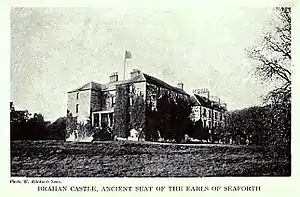Kenneth Mackenzie, 1st Earl of Seaforth
Kenneth Mackenzie, 1st Earl of Seaforth FRS (15 January 1744 – 27 August 1781) was a British peer and politician and Chief of the Highland Clan Mackenzie.


Origins
Mackenzie was the son of Kenneth Mackenzie, Lord Fortrose (died 1761) by Mary, the eldest daughter of Alexander Stewart, 6th Earl of Galloway. His paternal grandfather was the attainted William Mackenzie, 5th Earl of Seaforth, whose estates he repurchased from the government. The Earls of Seaforth descended from the ancient family of Mackenzie of Kintail.[1]
Career
Mackenzie was created Viscount Fortrose and Baron Ardelve in the Peerage of Ireland on 18 November 1766. He was a Member of Parliament for Caithness from 1768 to 1774. On 3 December 1771, he was created Earl of Seaforth (a new peerage, also in the Peerage of Ireland).[1][2]
On 12 November 1772, Mackenzie was elected a Fellow of the Royal Society.[3]
He was commissioned lieutenant-colonel and raised a regiment, the Seaforth (Highland) Regiment serving as its Colonel in Chief from 29 December 1777.[4] He sailed with them to the East Indies, but died at sea in 1781.[1] He was succeeded as Lieutenant-Colonel Commandant by Thomas Frederick Mackenzie Humberston.[5]
On his death his Irish earldom became extinct. He was succeeded as Chief of the Clan MacKenzie by his cousin Thomas Frederick Mackenzie Humberston.
Family
Mackenzie married first Lady Caroline Stanhope (1747–1767), daughter of William Stanhope, 2nd Earl of Harrington by whom he had one daughter, Lady Caroline Mackenzie (1766–1847), who married Louis Drummond, Comte de Melfort (d. 1833) and had children. He married secondly Harriet Powell, or Lamb (died 11 December 1779), the daughter of an apothecary.[6] Sir James Balfour Paul describes her tactfully as "a fashionable beauty of the town",[1] but Horace Bleackley is rather more explicit:
The graceful Harriet Powell, equally frail and famous, whose winsome face was portrayed in many a mezzotint, had spent her early youth as an inmate of Mrs Hayes's disreputable establishment in King's Place, but now at last she had become faithful to one man, and was keeping house with Lord Seaforth, the creator of a famous regiment.[7]
Reputation
Seaforth's biographer has summarised him as:
...a dandy, musician and connoisseur, an adventurer and lady's man, Chief of his Clan, and founding Colonel of his own regiment. A child of the Enlightenment, he delighted in its achievements and greater freedoms - and took full advantage of both. But he was born with too great a sense of entitlement and too little sense of responsibility, and he never found any firm purpose in life.[8]
References
- Sir James Balfour Paul, The Scots Peerage, volume 7 (David Douglas, Edinburgh, 1910), at pages 512-513
- "No. 11196". The London Gazette. 12 November 1771. p. 3.
- The Royal Society Library and Information Services, List of Fellows of the Royal Society, 1660-2007
- Scottish Highlands: Highland Clans and Regiments
- "No. 12270". The London Gazette. 16 February 1782. p. 1.
- "MACKENZIE, Kenneth, 1st Visct. Fortrose [I] (1744-81), of Seaforth". History of Parliament Online. Retrieved 13 June 2019.
- Horace Bleackley, Ladies fair and frail: sketches of the demi-monde during the eighteenth century (J. Lane, London, 1910), at page 207
- Tony Scotland, Gimcrack: a Rake's Progress (Shelf Lives, Baughurst, 2020)
| Parliament of Great Britain | ||
|---|---|---|
| Vacant alternating constituency Title last held by John Scott(to 1761) |
Member of Parliament for Caithness 1768–1774 |
Vacant alternating constituency Title next held by John Sinclair(from 1780) |
| Military offices | ||
| New regiment | Lieutenant-Colonel Commandant of the 78th (Highland) Regiment of Foot 1777–1781 |
Succeeded by Thomas Frederick Mackenzie Humberston |
| Peerage of Ireland | ||
| New creation | Earl of Seaforth 1771–1781 |
Extinct |
| Viscount Fortrose 1766–1781 | ||
| Preceded by Kenneth Mackenzie |
Chief of Clan Mackenzie 1761–1781 |
Succeeded by Thomas Frederick Mackenzie Humberston |